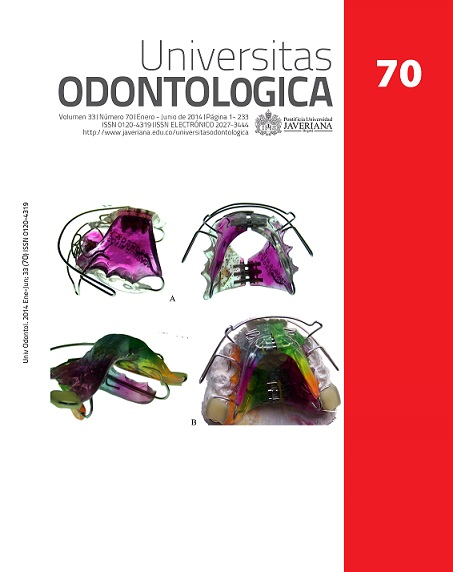Abstract
Background: Wala ridge analysis can be used to evaluate the amount of transversal development in the lower arch when the orthodontic treatment is finished. Purpose: To evaluate the lower arch in patients treated with passive and interactive self-ligation systems through Wala ridge analysis. Methods: The study used lower casts of 39 patients who were treated with the Damon, Quick, and In-Ovation systems (13 each) at the CIEO University Foundation in Bogota. Wala ridge of canines, first and second premolars, and first and second molars in initial and final lower casts was analyzed and compared with Andrews reference values (0.6, 0.8, 1.3, 2.0 and 2.2 mm respectively). Results: Measures of final casts of patients treated with the Damon system were 0.4, 0.4, 1.3, 1.9, and 1.8 mm. Measures for the Quick system were 0.4, 0.7, 1.3, 2.0, and 2.0 mm. In the In-Ovation system, measures were 0.2, 0.4, 1.3, 1.9, and 2.0 mm. Conclusion: Transversal development of the arches was achieved with the three systems. However, none of the systems attained the ideal post-treatment values suggested by Andrews, even though the Quick system was the closest.
KEYWORDS
orthodontics; Wala Ridge; transversal development; lower arch; self-ligation brackets
This journal is registered under a Creative Commons Attribution 4.0 International Public License. Thus, this work may be reproduced, distributed, and publicly shared in digital format, as long as the names of the authors and Pontificia Universidad Javeriana are acknowledged. Others are allowed to quote, adapt, transform, auto-archive, republish, and create based on this material, for any purpose (even commercial ones), provided the authorship is duly acknowledged, a link to the original work is provided, and it is specified if changes have been made. Pontificia Universidad Javeriana does not hold the rights of published works and the authors are solely responsible for the contents of their works; they keep the moral, intellectual, privacy, and publicity rights.
Approving the intervention of the work (review, copy-editing, translation, layout) and the following outreach, are granted through an use license and not through an assignment of rights. This means the journal and Pontificia Universidad Javeriana cannot be held responsible for any ethical malpractice by the authors. As a consequence of the protection granted by the use license, the journal is not required to publish recantations or modify information already published, unless the errata stems from the editorial management process. Publishing contents in this journal does not generate royalties for contributors.


